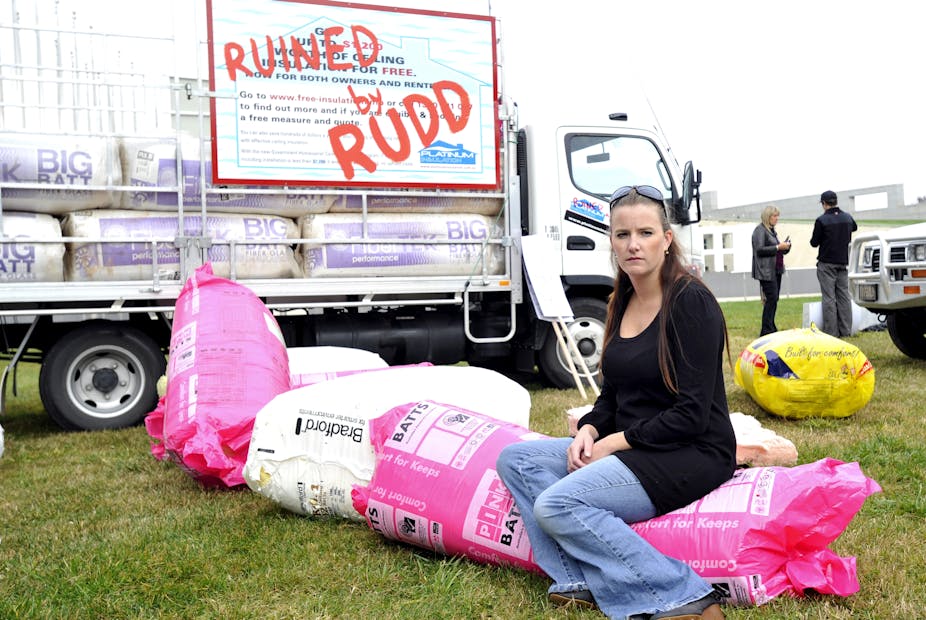The political fallout over the ill-fated Home Insulation Program continues, with former prime ministers Kevin Rudd and Julia Gillard now having been summoned to appear before the Abbott government’s royal commission into the program.
The infamous “pink batts scheme” claimed the lives of four young men before it was brought to an abrupt halt in 2010. And besides the tragic loss of life, the project was far from an unqualified success in terms of its stated goal of improving energy efficiency.
The scheme was hampered by poor installations, an overly narrow focus, and a failure to hit efficiency targets. However, it is also true that it delivered modest emissions reductions – and, crucially, it will give the construction industry valuable insight into how to do things better in the future.
What went wrong?
The Royal Commission is charged with finding out what can be learnt in terms of workplace health and safety to safeguard against similar future tragedies.
While those four young men’s deaths rightly remains the commission’s primary focus, as sustainability researchers it is important for us to also ask what lessons can be learnt about the way we build and insulate our buildings.
Poor installation practices compromised the scheme’s energy savings. Many installers failed to ensure that insulation was installed correctly, covered all areas of ceilings and used the correct type of insulation for the climate.
Too much focus was placed on the scheme’s benefit as an economic stimulus measure, which meant that the potential and predicted environmental outcomes were not achieved. Because of this, consumer confidence in the ability of governments to run large-scale energy efficiency programs has also been affected.
More importantly, the Home Insulation Program took a very narrow focus on improving household energy efficiency. It did not consider the energy and emissions associated with the production of the insulation products used, which would further reduce the reported energy savings. The reported energy and emissions savings pale into even further insignificance once the energy associated with the production, repair and maintenance of other materials used in house construction are considered.
Attempts to improve household energy efficiency must consider the total energy required over time. This is particularly critical, as research (see here and here) has shown that the energy required for house construction often far outstrips that associated with their operation.
When these indirect energy requirements are taken into account, the energy required for heating and cooling can account for less than 20% of a household’s total lifetime energy demand. In light of this, possible savings in energy and emissions are likely to be much less significant than typically reported and take much longer to achieve.
Why did it seem like a good idea at the time?
Household insulation is a good idea in principle. Households represent 25% of Australia’s power demand, of which heating and cooling typically account for around 40% and insulation is usually one of the most cost-effective ways of reducing a household’s energy use.
For this reason, in February 2009 the Australian Government introduced the Home Insulation Program as part of its Energy Efficient Homes Package, which in turn was part of its economic response to the global financial crisis.
As such, the scheme aimed to generate economic stimulus and support jobs and small businesses, as well as improve the energy efficiency of homes, by offering rebates to customers to offset the cost of installing ceiling insulation in their homes.
Then came the problems with poor and unsafe installations, linked to at least 224 fires, and the deaths of four young men. A year after the scheme began, it was abandoned.
What did the Home Insulation Program achieve?
The energy and emissions savings varied widely between households, depending on hours of occupancy, thermostat settings, system efficiency, conditioned area, and occupant behaviour. This makes it difficult to assess with any reliability the overall benefits to the 1.2 million households involved.
Despite this, it has been estimated that the scheme will save about 10 petajoules of energy per year compared with business as usual – a modest 1% of annual household electricity consumption – based on typical household characteristics up to 2020.
That translates to an emissions reduction of about a tonne of carbon dioxide per household, per year – or 10.5 million tonnes nationwide by the end of the decade. This figure is slightly lower than the 14.3 million tonnes estimated by the former Department of Climate Change and Energy Efficiency. The scheme’s overall emissions savings are likely to be much lower than was initially forecast, because its early curtailment meant that fewer homes were insulated.
What have we learned?
For all its failings, the Home Insulation Program has undoubtedly raised awareness of the benefits of home insulation.
It has also highlighted how policies in the construction and residential sector have not considered the full picture of energy efficiency over the full life span of a building.
Future policy must address the full range of energy demands associated with buildings. Without this, the significant environmental improvements that are needed within the construction and residential sectors will not be achieved.

